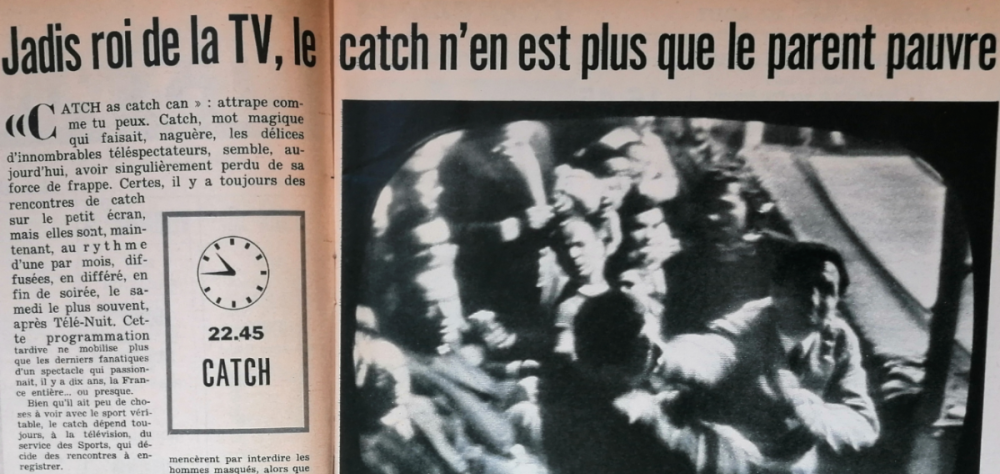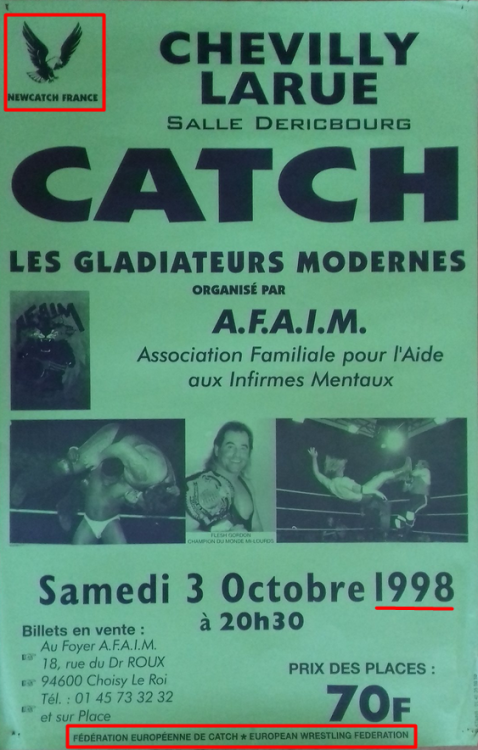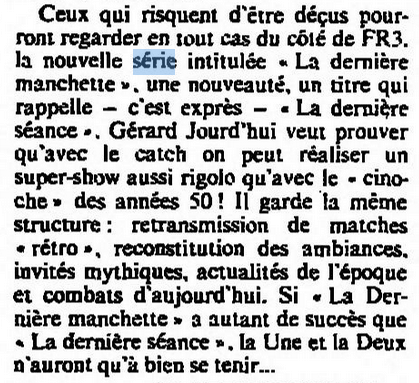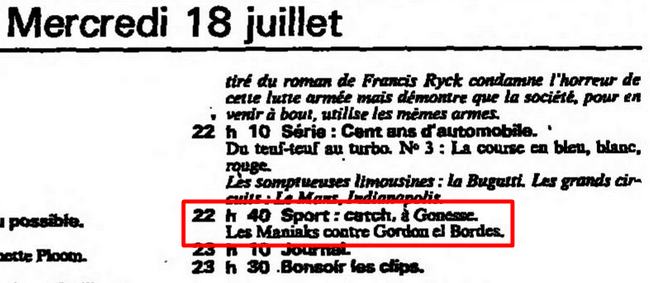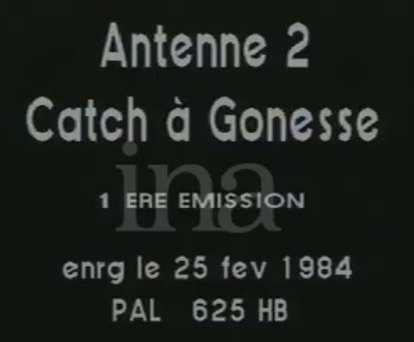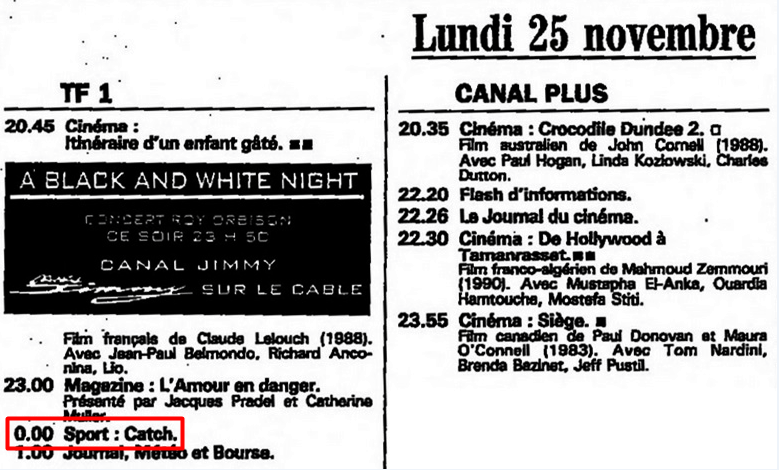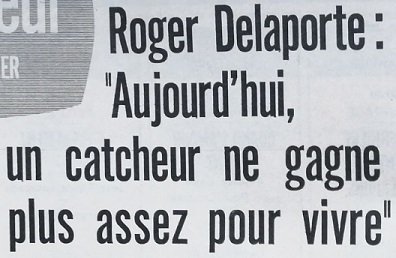
Phil Lions
Members-
Posts
214 -
Joined
-
Last visited
Content Type
Profiles
Forums
Blogs
Everything posted by Phil Lions
-
And now here's another promoter saying the same thing as Delaporte and Durand. Today's discovery. Promoter Alex Goldstein talking about, among other things, the adverse effect catch being on television had had on the live gates in the provinces. This is from April 1961, right before catch was about to be pulled from TV by Raymond Janot (the general director of RTF). - Interviewer: Do the catch organizers want catch to continue to be televised? - Alex Goldstein: I'll give you my personal opinion. I think that television has done considerable harm to my show, while catch did a lot for TV. Catch sold a large number of receivers. That provided work for the workers who make the sets! But if tomorrow, in the current state of affairs, catch matches were banned from television, I would shout: "Bravo, Mr. Janot! Keep your paltry little fees, I'm going to have many more customers in my theaters!" - Interviewer: So the influence of televised catch on your revenue is so great? - Goldstein: It is very great, and sometimes catastrophic in the provinces. You know that there can be six or seven catch shows organized in the provinces on the same evening. Now, if that evening L'Ange Blanc, for example, is on television, half the people will stay at home in front of the screen! So, you understand that the organizers are right to complain. - Interviewer: So you think that television doesn't pay you enough, in relation to the loss of customers suffered? - Goldstein: We receive a ridiculous fee: 200,000 francs for two-person catch, 225,000 to 250,000 francs for four-person catch. While our show reaches several million people! If each viewer who likes catch gave us just 50 francs, admit it wouldn't be much, the viewer would surely agree, and our accounts would be fine! - Interviewer: So you no longer want to work with TV? - Goldstein: I think the question is to be reviewed with the launch of the second channel. But in any case, the number one problem to be resolved are the financial conditions. - Interviewer: In your opinion, how often should television broadcasts be? - Goldstein: This question is linked to the previous one. To be reviewed, depending on the conditions. - Interviewer: We know that the majority of viewers demand catch. But you tell us that televised public meetings take away from your audience. Wouldn't it be possible, and would it be a way to satisfy everyone, if catch matches are staged in a studio, exclusively for the small screen? - Goldstein: No, I answer absolutely no! Wrestlers need the atmosphere of the room, the reactions of the audience. If you deprive them of that, the quality of the matches will suffer. They are like theater or music hall artists! They need contact with the spectators. The more atmosphere, the better! And on that final topic of studio wrestling, there was actually a one-off studio match that aired in 1966: Vassilios Mantopoulos & Ischa Israel vs. Billy Catanzaro & Gilbert Lemagourou with the popular music star Johnny Hallyday as guest commentator. It aired as part of the popular weekend show "Télé Dimanche" and was broadcast from the show's studio. Overall though the French promoters themselves were always against the idea of studio wrestling so that's why French catch never went that route.
-
You would know better than I would. Thank you for sharing this context. All I can say is that I've seen several articles pointing to "the cult of the strong man", as they would put it, fading away as one of the main reasons for boxing's decline in the 1960s and 1970s. So that's what I was basing my writing above on. Not my area of expertise so I can't say how correct it is, but I have come across this claim several times.
-
I'm no expert on French TV either, but I believe the decline of catch coincided with the rise of football (soccer) and some other sports. Because catch was easy and cheap to broadcast, it was adopted by television relatively early on while sports such as football were more difficult/expensive to air so they didn't become a regular fixture on French TV until the 1960s-1970s, and by the 1980s football was without question the most popular sport in the country. And this actually ties with another factor that I'm far from an expert on, but I believe it too played a role in the decline of catch. In the 1960s French society was changing, resulting in the large-scale May 1968 protests and strikes. One aspect of these societal changes was that the so-called "cult of the strong man" was going away. In other words, the views toward masculinity were changing and the traditional male values (strength, toughness, competitiveness, etc.) were no longer valued as much. Boxing, which used to be one of the most popular sports in France for decades, had a big dip in its popularity in the 1960s and especially in the 1970s, and I don't think it's recovered since. I've seen a number of mentions that the societal changes that were taking place back then, particularly the views toward masculinity, had a big hand in boxing's loss of popularity. I would imagine these societal changes impacted catch in a similar way as boxing. Also, talking about there not being that many televisions, you reminded me to mention these interesting stats that I found. As of January 31, 1958, there were only about 700,000 registered television sets in France (and I'm guessing there were also a number of unregistered ones too). As of December 31, 1960, the number of registered TV sets was up to about 2 million, which comparatively speaking was a big rise and I've actually seen a couple of mentions that partially credited catch for this rise. Overall though with RTF being around since 1949 and France having a population of about 45 million people, that's definitely a slow TV penetration rate. For sure slower than the US or the UK. That said, it should be pointed out that back then watching TV had a social aspect to it as not only would the whole family gather together to watch TV, but neighbors or friends might come over as well to watch certain shows, if they didn't have a TV of their own. Some bars and pubs also had TVs and people would go there to watch (and catch being on TV was a strong draw for the pub/bar owners back then). So, despite there being only 2 million registered TV sets, the potential viewing audience was larger than what that number suggests at first glance.
-
As I keep digging into the history of French catch, I keep finding new stuff. Today's discovery is this neat little summary of the state of catch on TV in August 1970. "Once the king of TV, catch is now just the red-headed stepchild Catch, the magic word that once delighted countless viewers, seems to have lost a significant amount of its appeal today. Of course, there are still catch matches on the small screen, but they are now broadcast at a rate of once per month, delayed [taped in advance], late in the evening, most often on Saturdays, after Télé-Nuit. This late-night programming now only attracts the last fanatics of a show that, ten years ago, fascinated the whole of France... or almost*. Although it has little to do with real sport, catch still depends, on television, on the Sports Department, which decides which matches to record." And this matches everything else I've found so far. By the end of the 1960s catch had lost a lot of its appeal to the general public. It still had a solid fanbase and among the late-night TV programming it was a top performer viewership-wise, but overall it was nowhere near as popular as it used to be and it was no longer relevant on a mainstream level. It's no coincidence Delaporte got out of catch promotion in 1970... (he did return several years later when the other genres he was promoting stopped making him money). * Here's an interesting little tidbit about the "whole of France... or almost" bit. Back in the day the "TV Guide" type of magazines in France used to do reader polls. In the annual 1960 reader poll of one of the magazines, close to 80% of the 30,000 respondents said that they watched catch. Obviously, the opinions of thirty thousand people are not a great representation of the 45 million population of France back then, but this does give you some idea how relevant catch used to be among the general public back in its heyday.
-
Interesting articles. I hadn't seen them before. Thanks! That said, I can spot several mistakes right away. A couple of examples below. No. The 1987 magazine show was "Sports loisirs" and it was an afternoon show on the weekend. "Minuit sport" was the magazine show (Mondays at midnight) that New Catch was part of in 1988. The part in the article about FEC going on hiatus in 1996 is definitely not true either. Flesh continued to have an active schedule after that too and was using the FEC name as late as October 1998. Here's a fun fact. IWSF and WS were actually created as associations (i.e non-profit organizations) on the exact same day... in June 2002. One in Othis, the other in Paris. And later WS was also created as a company (i.e. business entity for profit) in 2008, and terminated in 2013. This is all traceable in the archives dealing with French associations and companies. Anyway, this is where I'll stop discussing all of these various names further. They're inconsequential and not worth discussing in detail, IMO. That's Marc Mercier's version of the story, and I don't know if I believe it. When Mercier talks about FFCP he always talks about it as if it used to be a wrestling promotion (it was not), says that it was founded in 1931 (not true) by Raoul Paoli (not true) with Alex Goldstein being the second FFCP president (not true) and Delaporte being the third (not true). In other words, he always tries to paint his FFCP as some sort of official continuation of French catch's greatest promoters/promotions from the past and that's just not true. So yeah, I very much doubt that he bought anything from Delaporte, who to the best of my knowledge was never part of the original FFCP in an official capacity anyway.
-
I went down into the Flesh Gordon rabbit hole yesterday, trying to piece together more of the history of his promotion. And having looked at over 100 posters/programs/flyers for shows of his promotion (from the 1986-2025 period) I can honestly say I have never seen a promotion go through so many promotional names as Flesh's company did. So many, it can make your head spin! At one point or another he used: New Catch / Federation Europeenne de Catch / European Wrestling Federation / NewCatch France / Federation Internationale de Catch Amateurs et Professionnels / Euro-Catch / International Wrestling Stars Federation (IWSF) / Wrestling Stars (WS) / Catch WS / Les Maitres du Ring (which is what it's going by currently). And in looking into the promotion I was reminded of something I had forgotten about. Back in 2009 and 2010 Flesh Gordon teamed up with a production company and they ran three shows at Cirque d'Hiver in Paris, which of course has a long history of catch since it was Alex Goldstein's base of operations for many years. Those were the first catch shows at the venue, I believe, since 1980 or so when the Goldstein promotion closed shop (well, actually, by that point it was more so the Rene Ben Chemoul promotion because Goldstein had stepped away a few years prior). The Flesh Gordon shows at Cirque d'Hiver were billed as "Les Virtuoses des Rings Europeens" and the first one was actually filmed as a TV pilot with the idea to use it as proof of concept and try to land a national television deal. PCO worked the taping as one of the headline attractions and his opponent ended up being Brodie Lee. Very random! Of course this was happening right as catch was experiencing a big resurgence in its popularity in France due to WWE airing on free-to-air TV, which is why Gordon was hopeful he might be able to land a TV deal somewhere. He did not. The show in question does exist somewhere as a DVD, but online you can only find a short highlight video from it and this match below, which I'd say looks pretty good production-wise. In November 2008 the W9 network in France aired a one-off show by the touring Irish company American Wrestling Rampage, which was a success in terms of viewership so they followed it up with a second show the following year. And if you compare the AWR production with the match above, the Flesh Gordon show looks better, but obviously AWR featured ex-WWE names so that made it more appealing from a television perspective. In December 2008 W9 did actually announce their intent to air some FFCP content the following year, but ultimately they did not and instead ended up signing a deal with TNA. In general Marc Mercier had been shopping around a FFCP reality show concept, similar to "Star Academy", but it never got off the ground. In 2010 even ROH managed to get a TV deal in France, albeit a very short-lived one (they got canceled after only two months). Long story short, 2008-2010 was probably French catch's last chance of getting back to national television in France as interest in wrestling was way up, but despite Gordon and Mercier's attempts obviously things didn't work out and clearly French television networks were more interested in American wrestling content than they were in French wrestling content.
-
^ Olivia Mongho and Olga Diennesch are two of the women in the match footage. Yes, until 1977. Before that women's wrestling in Paris was only allowed at night clubs, cabarets, etc.
-
That would've been the case only if the networks cared about house shows, which they didn't. Not their business. They wouldn't rearrange their TV schedule because of some catch promoter's house show. And besides, I don't think there were many regional catch broadcasts anyway. Certainly not enough for them to be a big factor in the catch business.
-
By the way, a bunch of people talked about this issue. It wasn't just Delaporte. It was an issue even at the peak of French catch. For example, here's a quote by Maurice Durand from April 1961, right after catch had been taken off TV: Question: So you are in favor of completely eliminating catch from TV? Maurice Durand: No, I just think that we shouldn't overdo it, and that we should be careful about the quality of the show. One session per month would seem perfect to me. When catch was shown every week, it was catastrophic for the catch organizers in the provinces. The announcement of televised catch demolishes the other sessions, which barely attract half-full audiences... And that's a big reason why when catch returned to TV later in the year it was with a more reduced schedule.
-
Alright, here's the New Catch run in 1988. If you were to go by the TV listings alone you wouldn't even know New Catch was on TF1. I found zero mentions of it (at least in the TV listings as they were in the newspaper I searched through). The reason for that is because New Catch wasn't a standalone series. It was part of a sports magazine show along with a bunch of other sports so the TV listings would mention only the name of that show. New Catch was airing on Monday nights, always after midnight and on a couple of occasions even after 1 am so less than ideal time slot, to say the least, especially for a show that was clearly targeting a younger audience. New Catch was typically about 25 minutes or so. INA has all of the matches I've mentioned below [except for the last two which are not complete]. They don't seem to have the October 17 broadcast of the magazine show, which likely had New Catch on it. They're also missing some of the September episodes of the magazine show so I can't confirm if October 3 was the start date of New Catch, but I think it most probably was (it definitely hadn't started yet as of September 1 and it wasn't part of the September 19 episode either). New Catch on TF1 definitely wrapped up on December 26, because from the next week onward TF1 started airing a different wrestling show, but I'll leave that interesting tidbit for a bit further below. ----------- New Catch on TF1: October 3, 1988: Otto Wanz vs. Rocky Montana (Luc Poirier) Flesh Gordon & Prince Zefy vs. Eliot Frederico & Kato Gipsy October 10, 1988: Johnny Mantell vs. Last Warrior (Boris Cervankovic) Le Marquis Richard de Fumollo vs. Gerard Bouvet Salvatore Bellomo vs. Le Commando October 24, 1988: Drew McDonald vs. Billy Samson Mark Rocco vs. Danny Boy Collins October 31, 1988: Giant Haystacks vs. Franz van Buyten Flesh Gordon & Prince Zefy vs. Pat O’Hara & Jessy Texas New Catch was off TV for two weeks and when it returned it had a pair of new sponsors (which are prominently displayed on the ring and in the arena) November 21, 1988: Fit Finlay vs. Jimmy Kung Fu (Ed Hammill) Prince Zefy vs. Dick Murdoch (Alain Lesage) November 28, 1988: Flesh Gordon vs. Dick Murdoch (Alain Lesage) Le Marquis Richard de Fumollo vs. Claude Rocca Tony Lamotta vs. Eric Lacroix December 5, 1988: Marty Jones vs. John Harris Yann Caradec vs. Black Shadow December 12, 1988: Dave Taylor vs. David Morgan Mister Kong vs. Giro de la Monica Le Marquis Richard de Fumollo vs. Tony Lamotta December 19, 1988: Otto Wanz vs. Dave Taylor + at least one more match [INA doesn't seem to have the full broadcast] December 26, 1988: Mister Kong vs. Danny Garnier + at least one more match [INA doesn't seem to have the full broadcast] ----------- So, get this. The sports magazine show on TF1 that New Catch was part of was actually first spotlighting AWA from Las Vegas. Just like New Catch, 25 minutes or so of it every week. AWA was on TF1 as early as late April 1988 or at least that's the earliest mention that I found. AWA aired for sure through September 1 and then obviously in October they went with New Catch instead. And then from the first week of 1989 they replaced New Catch with WCCW. After that INA's records get very thin and the TV listings are of no use either, but it seems like catch was still part of the sports magazine show as late as August 1989. And I know that in March they were showing Memphis Wrestling. Yes, there were some regional repeats of matches on various France 3 regional channels, but more interestingly than that there were also some matches that were broadcast only regionally. Came across a few (in 1982-1991). The 1987 matches were part of a sports magazine show on FR3. Just occasional filler content. Nothing significant. ----------- On a final note, INA also has a couple of random regional broadcasts from places like New Caledonia and Guadeloupe. I mean, Rocky Johnson teaming with Joe Gomez to take on Dennis Knight and Chris Markoff in Guadeloupe in 1992 is as random as it gets. They only have highlights from that one though, and pre-match promos, but they do have a 40-minute Gomez vs. Knight match that preceded the tag match. There's also a 1989 show in New Caledonia with what seems to be a crew from Australia (John Tolios, the masked Black Scott, Lou Marcello, Gary Scott, Eddie Williams and Vic Murray were the names I could recognize the announcer mentioning).
-
Another note. The original broadcast date of this match was October 31, 1988 (well, November 1 technically since it was on after midnight). It aired on TF1. The INA version includes the full Haystacks interview and a van Buyten interview before it. EDIT - In fact, turns out INA has most of the 1988 New Catch footage, but apart from the Haystacks/Buyten match above the rest of the footage is not labeled with "catch" so it doesn't show up if you search for catch (hence why no one had really spotted it before).
-
Here's what catch aired on TV in France in 1984 and 1985. INA has all of the footage, but a few of their listed air dates are not correct. Here is the correct info: In 1984* on A2: - July 4: Black Shadow vs. Angelito + Marquis Edouard Fumolo vs. Georges Cohen [taped on February 25] - July 18: Flesh Gordon & Walter Bordes vs. Les Maniaks [taped on February 25] - July 25: Mongo le Primitif vs. Patrick Lopez + Marquis Edouard vs. Gerald Malpard - August 8: Mongo le Primitif vs. Eliot Frederico + Georges Cohen vs. Anton Tejero - August 15: Angelito & Flesh Gordon vs. Black Shadow & Eliot Frederico - August 22: Mambo le Primitif vs. Flesh Gordon & Angelito - August 29: Georges Cohen & Gass Dhoukan vs. Eliot Frederico & Mano Negra * INA has an additional match (Flesh Gordon & Angelito vs. Les Piranhas) listed as having aired on July 18 along with another two matches that for sure aired on other dates so that date is clearly wrong. And I think there's a decent chance this match ended up not airing. La Derniere Manchette in 1984 on FR3 (the current-day matches only): - July 21: Linda Blair vs. Nicky McDonald - July 28: Franz van Buyten vs. Bob Ufo - August 11: Brigitte Borne vs. Leo Dewerdt - August 18: Marc Mercier & Pierre Mercier vs. Albert Sanniez & Mario Petrolini - August 25: Linda Blair & Nicky McDonald vs. Brigitte Borne & Martine Gowart - September 1: Franz van Buyten & Mr. Montreal vs. Bob Ufo & John Harris In 1985** on A2: - July 7: Mambo le Primitif vs. Les Golden Falcons - July 14: Flesh Gordon & Kader Hassouni vs. Marquis Richard & Black Shadow - July 21: Mambo le Primitif vs. Jessy Texas + Georges Cohen & Kader Hassouni vs. Anton Tejero & Pierre Lagache - July 28: Angelito & Flesh Gordon vs. Kato Bruce Lee & Eliot Frederico - August 4: Georges Cohen & Gass Doukhan vs. Black Shadow & Kato Bruce Lee - August 11: Angelito, Flesh Gordon & Walter Bordes vs. Marquis Richard, Jessy Texas & Eliot Frederico - August 18: Flesh Gordon & Walter Bordes vs. Les Maniaks [taped on March 2] - August 25: Marquis Richard & Black Shadow vs. Marcello Motta & Angelito [taped March 2] - September 1: Flesh Gordon vs. Mambo le Primitif [taped on May 11] ** INA has an additional match (Kader Hassouni & John DeBruyne vs. Les Piranhas), which was taped on May 11, that I'm pretty certain never aired. And that 1985 summer run on A2 ended catch's streak of airing on national television for 31 consecutive years (1954-1985), albeit not always regularly. On an another interesting catch TV note, looks like FEC/EWF's run on TF1 in 1991 lasted only four weeks (November 11-December 3). Catch is not mentioned in the TV listings before and after those dates.
-
LDM was a series. It aired every week, except one, from July 21 until September 1, 1984. Then it was done. It was re-aired the following year on TV5. Here's an article talking about the debut of the series. Based on the TV listings, WWF started airing on Canal Plus in July 1985. Only for about six weeks though. Then it was off the channel and returned again in late December 1985.
-
Flesh had zero to do with it. The only reason for the slight increase in broadcasts (13 in total for the whole year) was La Derniere Manchette. A2 once again brought catch back (in this case Flesh and his guys) as filler summer programming for a few weeks, and at almost the exact same time FR3 decided to do the La Derniere Manchette show (which was a mix of retro matches, current day matches and some other stuff). Hence the increase in broadcasts. LDM on FR3 was airing in prime time on Saturdays around 9:20 pm and had a 70-minute time slot while the A2 shows were on Wednesdays around 10:30 pm and were slotted only for 30 minutes. Just finished looking into 1984 and it's good to point out some of INA's dates are actually the taping dates. For example, they have the Gordon/Bordes vs. Maniaks match listed as having aired on February 25, but it actually aired on July 18. February 25 was when it was taped and it even says so at the start of the footage (enregistré le 25 February / recorded on 25 February).
-
I've gone through the available French TV listings from 1974 to 1983 and in comparing those with what INA has it looks like INA's missing only about seven or eight TV matches altogether from the 1978-1983 period. Up to 1978 things are clearly on the decline for catch on TV, but still kind of alright with there being somewhat regular broadcasts (more than 10 per year, but less than 20). And then after 1978 and up to 1983 things get more dire and catch is airing on TV less than 10 times per year (and for half of those years the number is closer to 5 than it is to 10). There's also a clear pattern emerging where there'd be no catch on national TV for months, then A2 would bring it back as filler programming for a few weeks in the summer, and then there'd be no catch on TV again for months. This happened in 1980, 1982 and 1983. I know things are about to pick up a bit in 1984 though so at least there's that.
-
Just finished having a look through the TV listings in a 1975 newspaper* and I thought I'd compare with what INA has. At quick glance, I think a few of the matches are not available on @Matt D's channel. All the air times mentioned are pm. INA footage in bold. - March 8, 1975 (on TF1 at 10:30): no specific match advertised - April 13, 1975 (on A2 at 10:20): Al-Casi vs. Christian Preno + Daniel Schmid vs. Rocky James - May 11, 1975 (on A2 at 10:40): Eric Joly vs. Le Samurai + Daniel Schmid vs. Gilbert Wherle + Rene Ben Chemoul & Walter Bordes vs. Gerard Bouvet & Black Shadow** - May 24, 1975 (on TF1 at 10:45): a tag team match - June 13, 1975 (on A2): Gilbert Leduc & Jacky Corn vs. Der Henker & Le Samurai*** - June 19, 1975 (on A2 at 9:50 or 10:55 - conflicting info): from Cirque d’Hiver - June 28, 1975 (on TF1 at 10:25): no specific match advertised - July 13, 1975 (on A2 at 11:00): Gilbert Wherle & Daniel Boucard vs. Gass Dhoukan & Yanek Fryziuk - July 27, 1975 (on A2 at 10:45): no specific match advertised - September 7, 1975 (on A2 at 10:00): Iska Khan vs. Claude Jartel + Latif Salah vs. Daniel Boucard - September 14, 1975 (on A2 at 10:20): a tag team match - September 26, 1975 (on A2): Georges Cohen & Gass Doukhan vs. Pierre Payen & Daniel Boucard**** - October 12, 1975 (on A2 at 10:30): Yanek Fryziuk vs. Batistou - October 18, 1975 (on TF1 at 10:30): no specific match advertised - November 29, 1975 (on A2): Arpad Weber vs. Josef el Arz + Walter Bordes vs. Le Samurai***** * There are issues of the newspaper missing so the list of broadcasts may not be full. ** INA has the three matches as one video under that date, but the video is definitely two broadcasts posted as one. I think the Chemoul/Bordes tag is likely the May 24 broadcast, and it aired on A2, not on TF1 as advertised. *** Date could be wrong - the TV listings for that day don't mention catch. Could be the June 19 broadcast. **** Newspaper missing for that day. Can't check TV listings. ***** Catch was advertised for TF1 at 10:15 that night, but these matches clearly aired on A2 instead.
-
The date looks to be correct, technically. Catch was on at midnight (November 25th heading into 26th).
-
One more match to add to the list of aired matches that we're missing: Brigitte Borne vs. Leo Dewerdt (August 11, 1984). Speaking of "La derniere manchette", it lasted on France 3 for less than two months, and I just found TV listings confirming that the following year the episodes were re-aired on TV5. And here's a random TV listing for FEC/EWF on TF1 airing on a Monday night at 11:35 pm (November 11, 1991).
-
I have all of my research backed up so if something were to happen I'll just re-post it somewhere else. I don't know where, but somewhere.
-
I've just added the second part of my timeline on the history of French catch, covering the post-WWII period all the way to 1956. About 16-17 new pages of info. It's a long read, but it's all quite interesting, if I do say so myself. It's all here: https://bit.ly/FrenchCatchTimeline While the 1930s were a relatively peaceful era in French pro wrestling, the first half of the 1950s was most certainly not. It was a turbulent and interesting time with there being arguments about the curious phenomenon that was amateur catch, new federations being formed, new stars emerging, promotional wars going on, wrestlers and promotions switching sides, lawsuits being filed, the French state changing its stance on what catch was, television coming into the picture, tag team wrestling arriving amidst controversy and much more.
-
He doesn't outright say it, but I believe he meant French wrestlers specifically when he said that, because in the whole story he talks about French wrestlers only and later the story talks about the various jobs French wrestlers had taken on to make ends meet. That said, he is probably exaggerating a bit to make his point. Plus, there were plenty of, as Le Petit Prince used to refer to them with disdain back in the day, "Sunday wrestlers" too (i.e. semi-pro/local guys wrestling just as a hobby on the weekend), but there definitely weren't many proper French pros left by that point.
-
"Today, a wrestler doesn't earn enough to live" Came across an interesting story/interview with Roger Delaporte for one of the major French magazines in January 1977 where he laments the bad state of the business. Keep in mind, catch was still airing on TF1 at that point and I think later that same year it may have even been airing twice a week (on different networks), but despite this business was way down. Delaporte attributes it to a few factors: - Catch no longer airing live and instead typically on a delay of a few weeks, but the network wouldn't announce that it was pretaped. This allowed the network to plan their timing better and advertise in advance the exact time a show would end, which suggested to the public that all matches were fixed and therefore they lost interest. - Those taped shows would air mainly on Saturday night, which was a big night for catch live events, and having catch TV airing at the same time killed the live attendance. "We went from 5,000 spectators to 1,000 spectators. Even worse, one night I happened to be wrestling in a town and that same night a match I had wrestled in that town three months prior was airing on TV". - FFL (the amateur federation) no longer being in charge of catch led to "a multitude of bogus federations and a proliferation of promoters, resulting in total disorder." Multiple L'Ange Blancs, Bourreaus, Kamikazes... All sorts of guys now claiming to be World champion... - "In the past there were 300 wrestlers. Now there are barely 30 left. Simply put, catch shows are no longer profitable." - In the past there used to be tax exemptions for catch shows, this was no longer the case and now the promoters had to pay VAT. - Advertising in the press used to be free, now you had to pay for advertising in the newspapers. - Since July 1976 the state required wrestlers to be affiliated with Social Security and therefore money had to be deducted from the wrestlers' pay and the promoters' revenue to go to Social Security. And then the story makes it sound like Delaporte stopped promoting catch at Elysee-Montmartre in 1970 and he was to resume promoting now [1977]. It's not addressed in detail, but that is what the story suggests. There were definitely shows at Elysee in 1971-1976 so could it be that someone else was promoting there during that time (and Delaportre was simply leasing them the venue for the night)? I'm not sure, but this claim definitely peaked my interest. I'll try to find out more.
-
This is where I don't agree with your premise. There is no universal "they". The "they" in the 1960s were a completely different group of people than the "they" in the 1980s, and so was the TV landscape in general. Your premise is somewhat akin to saying that if Warner Bros. Discovery decided to cancel AEW tomorrow they'd base their handling of the cancellation on how AOL TimeWarner handled the WCW cancellation back in 2001. They won't. It's ancient history at this point. TV executives don't care about what happened 25 years ago to another group of executives. They only care about what is happening now and what will be happening going forward.
-
I don't think what was happening in the early 1960s has any connection whatsoever to what was happening in the 1980s. Completely different times with completely different people in charge. I highly doubt anyone remembered what had happened in the 1960s, let alone was basing any decisions on stuff that had happened in the 1960s. In the 1960s whenever catch got taken off TV the public would demand it back. By the 1980s I don't think the public cared that much, if at all, so I doubt the networks felt any pressure whatsoever about cancelling catch or gave it that much thought.
